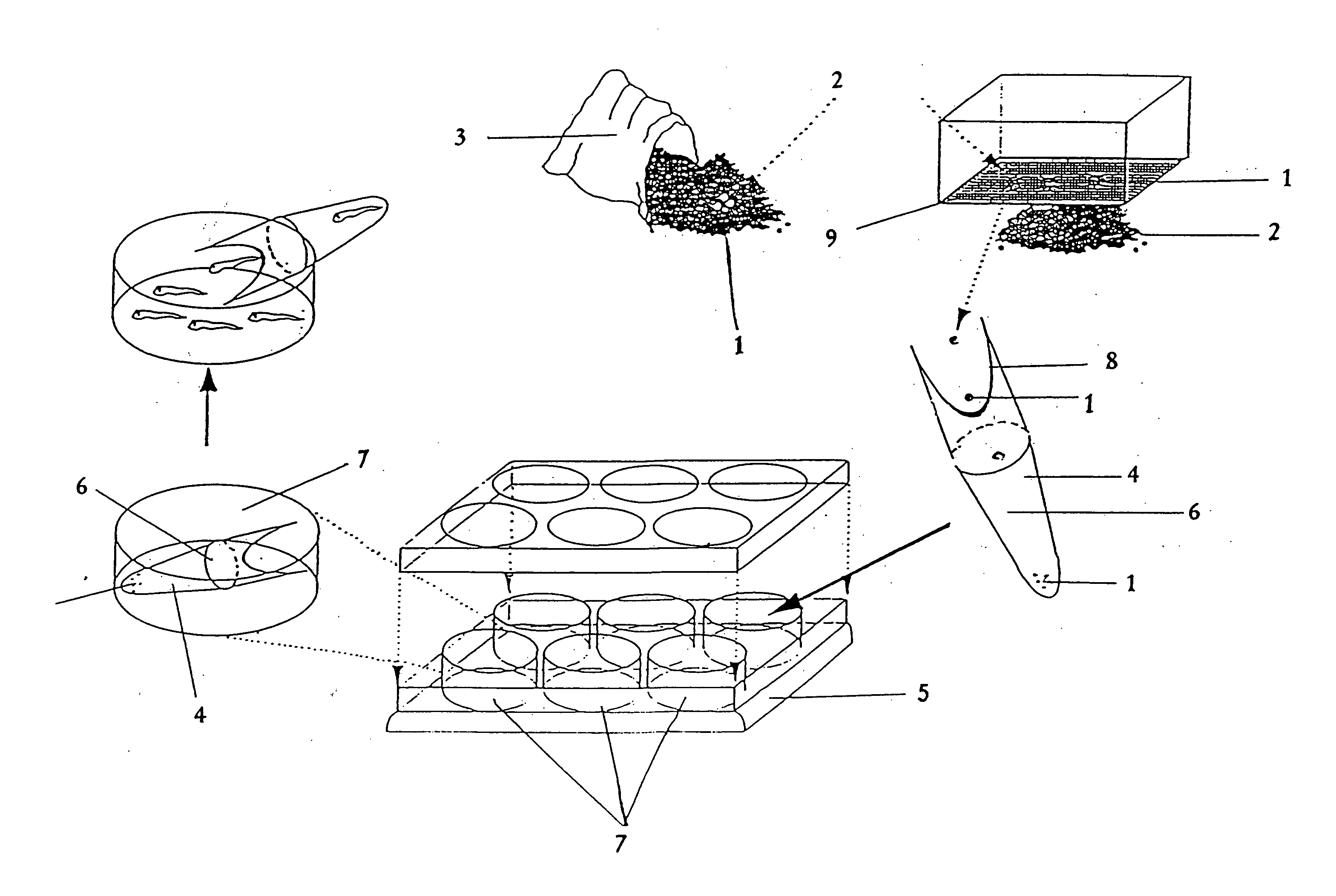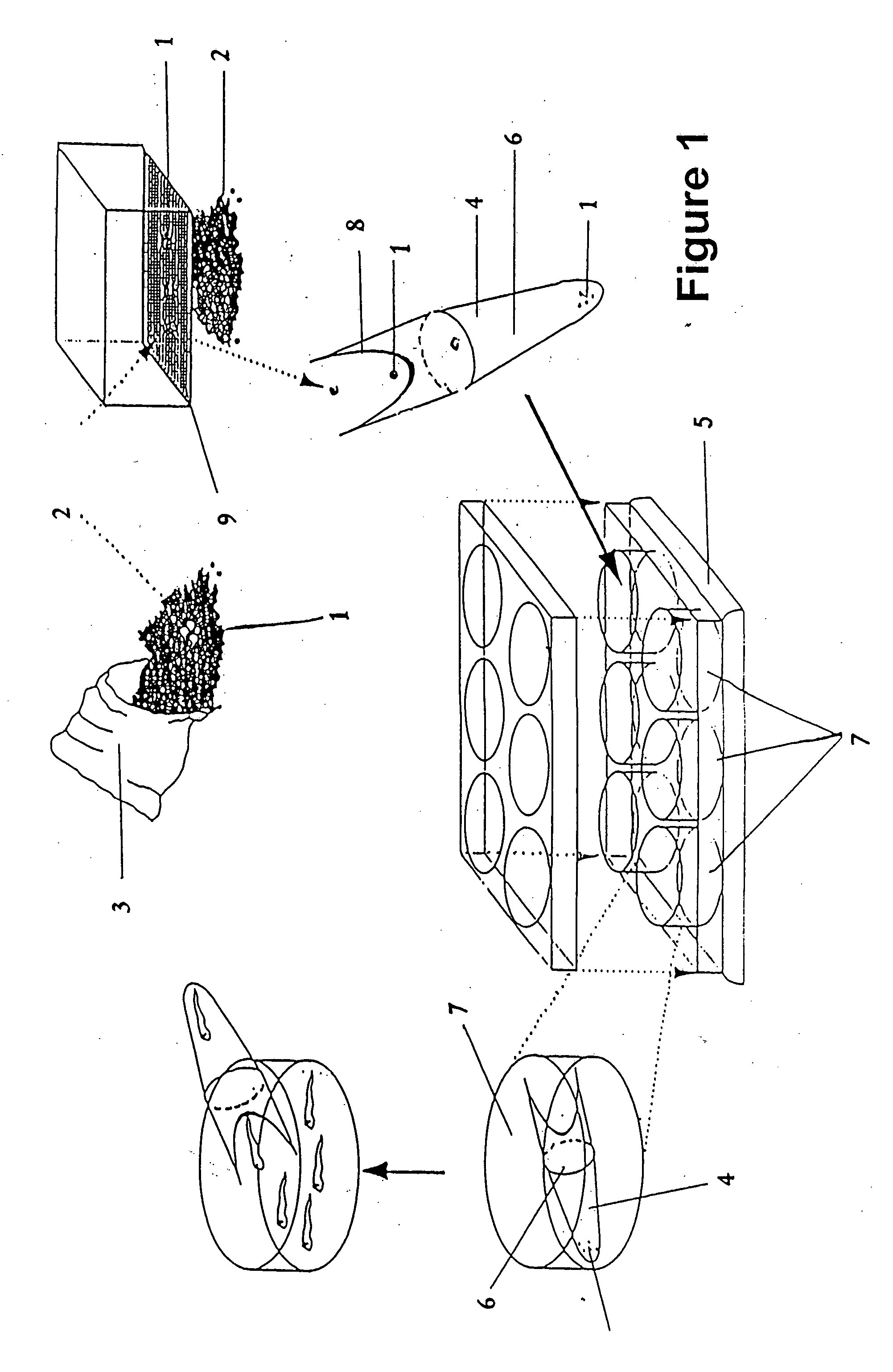Fish hatching method and apparatus
a technology for fish and embryos, applied in the field of animal husbandry, can solve the problems of high labor intensity, high cost, and specific age requirements of fish and aquatic macro-invertebrates in standard acute toxicity testing for environmental risk hazard assessment, and achieve the effects of short duration, cost-effectiveness, and special usefulness and cost-effectiveness
- Summary
- Abstract
- Description
- Claims
- Application Information
AI Technical Summary
Benefits of technology
Problems solved by technology
Method used
Image
Examples
example 1
[0062] Dilution Water Preparation. Dilution water utilized was a deionized ASTM Type 1 water with 48 mg / L NaHCO3, 26 mg / L CaCl(2H2O), 51 mg / L MgCl2 (6H2O), 2 mg / L KCl, and 2 mg / L NaCl added. Acceptable water quality parameters for the dilution water were as follows: pH (7.75-7.82), alkalinity (20-28 mg / L as CaCO3), hardness (40-44 mg / L as CaCO3).
[0063] Embrvo Storage And Receipt. Enough embryos were shipped via overnight airmail to perform tests (approximately 600 embryos per test chemical). Embryos received for testing were used immediately or placed in long-term storage at 21° C.-25° C. The storage area should be temperature controlled to avoid premature emergence of fry. The storage media consists of filter paper sealed in a petri dish (0 to 60 days) and / or a refined peat moss (particulate size <0.6 mm for greater than 60 days storage). Embryos were stored in these semi-humid conditions until needed for testing. The embryos were then extracted from the peat by straining the embr...
example 2
[0069] Embryo shipping and storage. Diapause 3 embryos stored. in saline-moistened filter paper were shipped overnight from Triops (Pensacola, Fla., USA) and were used within 24 h of arrival for testing unless noted otherwise. A minimum of 600 embryos per test chemical was used. For long-term storage, embryos were placed in sterile (autoclaved), moist (75% water by weight) peat moss ground to a particular size of <0.6 mm. Embryos stored in this medium in the dark at 21 to 25° C. have remained viable for at least 9 months.
[0070] Hatching. The following procedure was developed to promote hatching and to minimize trauma to hatchlings during subsequent testing procedures. Culture water was deionized American Society for Testing and Materials type I water containing 48 mg / L NaHCO3, 26mg / L CaCl—2H2O, 51 mg / L MgCl2—6H2O, 2 mg / L KCl, and 2 mg / L NaCl; the culture was aerated 24 hours before use. Acceptable parameters were pH 7.75 to 7.82; alkalinity, 20 to 28 mg / L (as CaCO3); and hardness, ...
example 3
Design of Toxicity Screenings
[0071] Test comunds. The 11 chemicals previously used for comparison of standard acute toxicity tests with rapid screening alternative procedures were selected. Zinc, cadmium, and copper were analyzed by inductively coupled argon plasma spectrometry; phenol, 2,4,-dichlorophenoxyacetic acid (2,4,-D), pentachlorophenol, and 2,4,6-trinitrotoluene (TNT), by high pressure liquid chromatography; malathion and 1-octanol, by gas chromatography; and sodium dodecyl sulfate, by ion chromatography. Unionized ammonia was analyzed with an Orion EA 940 specific ion analyzer (Beverly, Mass., USA) using an Orion model 95-12 ammonia electrode.
[0072] Test procedures. Toxicity tests were performed in triplicate at five concentrations (0.5 dilution factor) with control, in the same test wells in which fry were hatched (FIG. 1), in a Labline Biotronette incubator (Melrose Pak, Ill., USA) at 25° C. Nine milliliters of culture water was removed from each well and replaced wit...
PUM
| Property | Measurement | Unit |
|---|---|---|
| water content | aaaaa | aaaaa |
| humidity | aaaaa | aaaaa |
| size | aaaaa | aaaaa |
Abstract
Description
Claims
Application Information
 Login to View More
Login to View More - R&D
- Intellectual Property
- Life Sciences
- Materials
- Tech Scout
- Unparalleled Data Quality
- Higher Quality Content
- 60% Fewer Hallucinations
Browse by: Latest US Patents, China's latest patents, Technical Efficacy Thesaurus, Application Domain, Technology Topic, Popular Technical Reports.
© 2025 PatSnap. All rights reserved.Legal|Privacy policy|Modern Slavery Act Transparency Statement|Sitemap|About US| Contact US: help@patsnap.com


